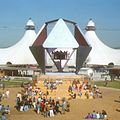Heureka (exhibition)

Heureka was the name of the national research exhibition that took place in Zurich from May 10th to October 27th 1991 on the occasion of the 700th anniversary of Switzerland . The Heureka site was on the Allmend in Zurich-Brunau on the banks of the Sihl . Georg Müller was responsible for the overall concept and implementation. At his suggestion, more than 1000 people from public universities and private research institutes agreed to explain their work to the visitors.
The external appearance was dominated by the white semicircular ring tent made of plastic, which was composed of eight individual tents. The tops of the middle four tents were connected by bridges, accessible via spiral stairs or elevators in the central supporting pillars. Each of the tents hosted exhibitions on a specific area of science.
The second characteristic building was the 52.5 meter high wooden "Galileiturm". The visitors reached the nine exhibition floors of the tower via the spiral-shaped outer staircase. The theme of the exhibition was the history of science.
The people's laboratory with physical experiments was located between the ring tent and the Galilei tower. There was the "Eureka polyhedron", a walkable octahedron that could be changed to a cuboctahedron (double the height and five times the volume). Inside was a visitor platform that was raised to a cuboctahedron during the change. A walkable suspension bridge connected various exhibition locations.
The original plan was to hold a national exhibition in 1991 on the occasion of the 700th anniversary of the Swiss Confederation . Since the project failed, the Eureka was implemented in Zurich .

